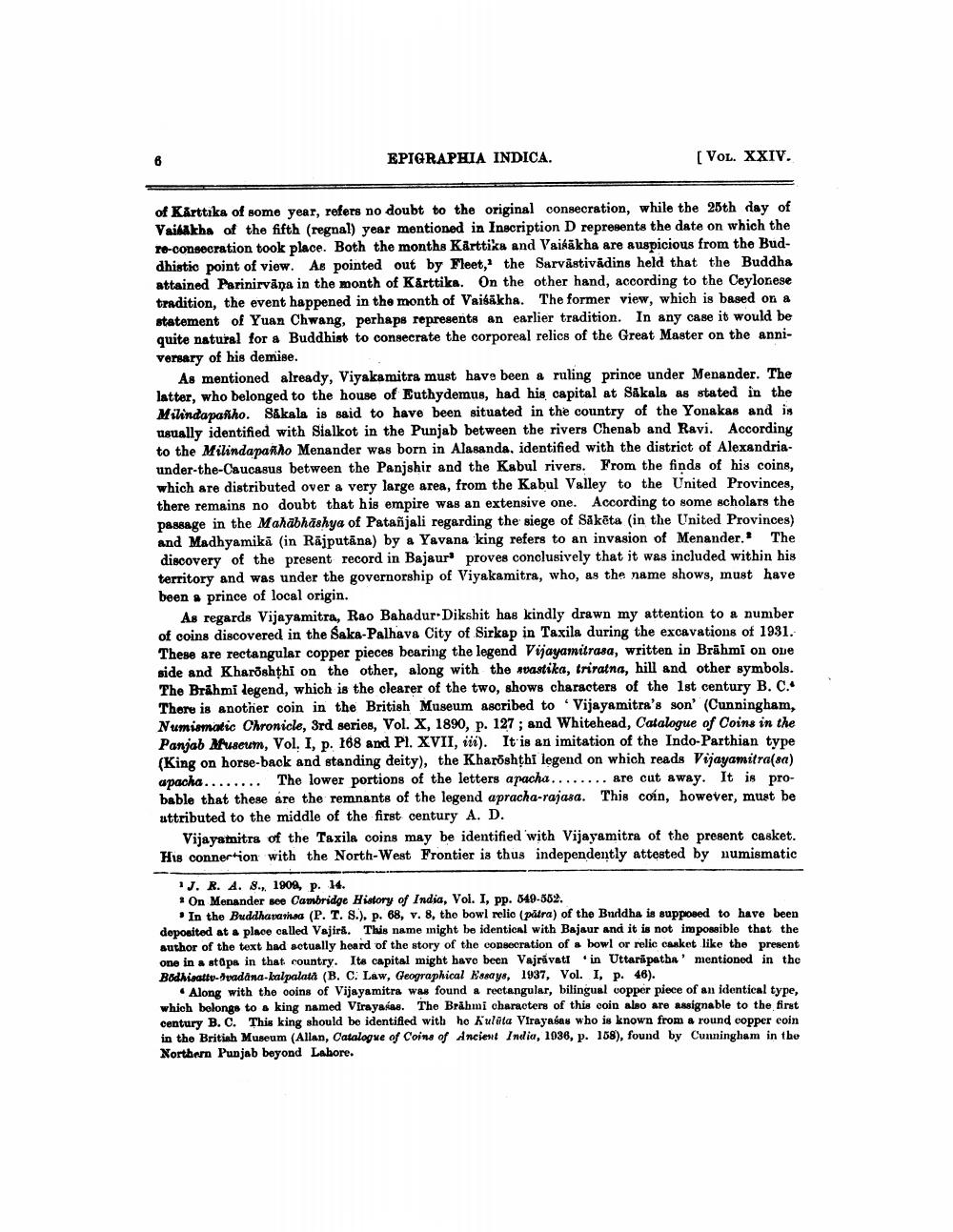________________
6
EPIGRAPHIA INDICA.
[VOL. XXIV.
of Kärttika of some year, refers no doubt to the original consecration, while the 25th day of Vaisakha of the fifth (regnal) year mentioned in Inscription D represents the date on which the re-consecration took place. Both the months Kärttika and Vaisakha are auspicious from the Buddhistic point of view. As pointed out by Fleet, the Sarvästivadins held that the Buddha attained Parinirvana in the month of Kärttika. On the other hand, according to the Ceylonese tradition, the event happened in the month of Vaisakha. The former view, which is based on a statement of Yuan Chwang, perhaps represents an earlier tradition. In any case it would be quite natural for a Buddhist to consecrate the corporeal relics of the Great Master on the anniversary of his demise.
As mentioned already, Viyakamitra must have been a ruling prince under Menander. The latter, who belonged to the house of Euthydemus, had his capital at Sakala as stated in the Milindapañho. Sakala is said to have been situated in the country of the Yonakas and is usually identified with Sialkot in the Punjab between the rivers Chenab and Ravi. According to the Milindapañho Menander was born in Alasanda, identified with the district of Alexandriaunder-the-Caucasus between the Panjshir and the Kabul rivers. From the finds of his coins, which are distributed over a very large area, from the Kabul Valley to the United Provinces, there remains no doubt that his empire was an extensive one. According to some scholars the passage in the Mahabhashya of Patanjali regarding the siege of Saketa (in the United Provinces) and Madhyamika (in Rajputana) by a Yavana king refers to an invasion of Menander. The discovery of the present record in Bajaur proves conclusively that it was included within his territory and was under the governorship of Viyakamitra, who, as the name shows, must have been a prince of local origin.
As regards Vijayamitra, Rao Bahadur-Dikshit has kindly drawn my attention to a number of coins discovered in the Saka-Palhava City of Sirkap in Taxila during the excavations of 1931. These are rectangular copper pieces bearing the legend Vijayamitrasa, written in Brahmi on one side and Kharoshṭhi on the other, along with the svastika, triratna, hill and other symbols. The Brahmi legend, which is the clearer of the two, shows characters of the 1st century B. C. There is another coin in the British Museum ascribed to Vijayamitra's son' (Cunningham, Numismatic Chronicle, 3rd series, Vol. X, 1890, p. 127; and Whitehead, Catalogue of Coins in the Panjab Museum, Vol. I, p. 168 and Pl. XVII, iii). It is an imitation of the Indo-Parthian type (King on horse-back and standing deity), the Kharöshṭhi legend on which reads Vijayamitra(sa) apacha....... The lower portions of the letters apacha........ are cut away. It is probable that these are the remnants of the legend apracha-rajasa. This coin, however, must be attributed to the middle of the first century A. D.
Vijayamitra of the Taxila coins may be identified with Vijayamitra of the present casket. His connection with the North-West Frontier is thus independently attested by numismatic
1 J. R. A. 8., 1909, p. 14.
On Menander see Cambridge History of India, Vol. I, pp. 549-552.
In the Buddhavarea (P. T. S.), p. 68, v. 8, the bowl relic (patra) of the Buddha is supposed to have been deposited at a place called Vajira. This name might be identical with Bajaur and it is not impossible that the author of the text had actually heard of the story of the consecration of a bowl or relic casket like the present one in a stapa in that country. Its capital might have been Vajravati in Uttarapatha' mentioned in the Bodhisattv-vadana-kalpalata (B. C. Law, Geographical Essays, 1937, Vol. I, p. 46).
Along with the coins of Vijayamitra was found a rectangular, bilingual copper piece of an identical type, which belongs to a king named Virayasas. The Brahmi characters of this coin also are assignable to the first century B. C. This king should be identified with he Kulita Virayasas who is known from a round copper coin in the British Museum (Allan, Catalogue of Coins of Ancient India, 1936, p. 158), found by Cunningham in the Northern Punjab beyond Lahore.




